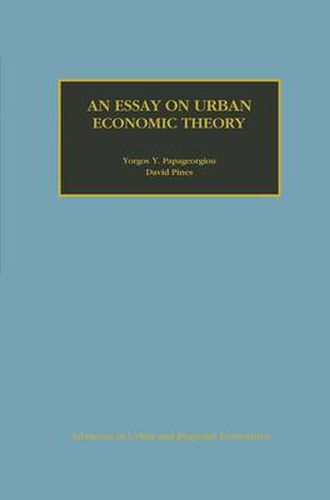Readings Newsletter
Become a Readings Member to make your shopping experience even easier.
Sign in or sign up for free!
You’re not far away from qualifying for FREE standard shipping within Australia
You’ve qualified for FREE standard shipping within Australia
The cart is loading…






This title is printed to order. This book may have been self-published. If so, we cannot guarantee the quality of the content. In the main most books will have gone through the editing process however some may not. We therefore suggest that you be aware of this before ordering this book. If in doubt check either the author or publisher’s details as we are unable to accept any returns unless they are faulty. Please contact us if you have any questions.
Urban economic theory has been one of the most active areas of urban and regional economic research. Static general equilibrium theory is at the core of modern microeconomics, and the topic of this book - the static allocation of resources within a city and between cities - is at the core of urban economic theory. This volume attempts to reflect the state of the field. Part I provides a rigorous presentation of several variants of the monocentric (city) model - as the centrepiece of urban economic theory - treating equilibrium, optimum, and comparative statistics. Part II explores less familiar and even some uncharted territory. The monocentric model looks at a single city in isolation, taking as given a central business district surrounded by residences. Part II, in contrast, makes the intra-urban location of residential and non-residential activity the outcome of the fundamental trade-off between the propensity to interact and the aversion to crowding; the resulting pattern of agglomeration may be polycentric. Part II also develops models of an urbanized economy with trade between specialized cities and examines how the market-determined size distribution of cities differs from the optimum. This book launches a new series, Advances in Urban and Regional Economics . The series aims to provide an outlet for longer scholarly works dealing with topics in urban and regional economics.
$9.00 standard shipping within Australia
FREE standard shipping within Australia for orders over $100.00
Express & International shipping calculated at checkout
This title is printed to order. This book may have been self-published. If so, we cannot guarantee the quality of the content. In the main most books will have gone through the editing process however some may not. We therefore suggest that you be aware of this before ordering this book. If in doubt check either the author or publisher’s details as we are unable to accept any returns unless they are faulty. Please contact us if you have any questions.
Urban economic theory has been one of the most active areas of urban and regional economic research. Static general equilibrium theory is at the core of modern microeconomics, and the topic of this book - the static allocation of resources within a city and between cities - is at the core of urban economic theory. This volume attempts to reflect the state of the field. Part I provides a rigorous presentation of several variants of the monocentric (city) model - as the centrepiece of urban economic theory - treating equilibrium, optimum, and comparative statistics. Part II explores less familiar and even some uncharted territory. The monocentric model looks at a single city in isolation, taking as given a central business district surrounded by residences. Part II, in contrast, makes the intra-urban location of residential and non-residential activity the outcome of the fundamental trade-off between the propensity to interact and the aversion to crowding; the resulting pattern of agglomeration may be polycentric. Part II also develops models of an urbanized economy with trade between specialized cities and examines how the market-determined size distribution of cities differs from the optimum. This book launches a new series, Advances in Urban and Regional Economics . The series aims to provide an outlet for longer scholarly works dealing with topics in urban and regional economics.